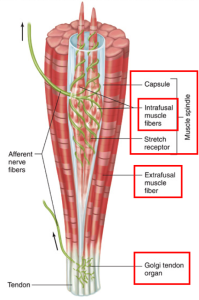The Science of Stretching
Post by Lily Gil, Personal Trainer, Nourish Northwest
The Science of Stretching
Most of us remember to do a quick stretch following an intense workout when our muscles are beginning to tense up. It feels good to lengthen those tight glutes or quads, after performing too many (aka the right amount) of squats and lunges. BUT, have you ever wondered what is going on in your muscles during a stretch or why after about 30 seconds into a toe touch stretch you can finally reach those toes? Read on to find out!
Mechanoreceptors are located inside muscles (and ligaments, bones, and joints) and are responsible for sensing distortion (i.e. stretching) in body tissue. Two types of mechanoreceptors that play a prominent role in muscle behavior are muscle spindles and Golgi tendon organs. Muscle spindles are sensitive to the change in length of a muscle and the rate at which that length change occurs, while Golgi tendon organs are sensitive to the change in tension of a muscle (i.e. how tense a muscle is) and the rate of that change. When a muscle is placed under excessive stress from being engaged/contracted for too long, the Golgi tendon organ kicks in, causing the muscle to relax and also prevent injury. On the other hand, when a muscle is lengthened, the muscle spindles are stretched and become excited, causing the extended muscle fibers to contract. This prevents the muscle from stretching too far too fast (i.e. hyper extending), which could cause injury.
Stick with me! Here’s how it plays into stretching.
When the Golgi tendon organ is excited for a prolonged period of time (at least 30 seconds according to National Academy of Sports Medicine), it provides an inhibitory effect to muscle spindles, which are trying to contract the muscle. This means, that when we hold a stretch for long enough, the Golgi tendon organ overrides the muscle spindle activity, causing relation in the overactive muscle, allowing for it to be stretched to its optimal length. It takes about 30 seconds for this override to occur, which is why it’s so important to hold stretches for solid amount of time in order to really stretch out a muscle.
There you are! Now when you’re struggling to reach your toes and stretch out those hamstrings, remember to hold the stretch and continue breathing into it for around 30 seconds in order for the muscles to begin to relax. Happy stretching!!




